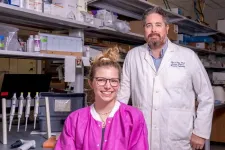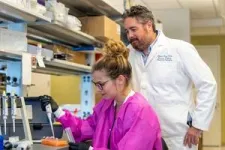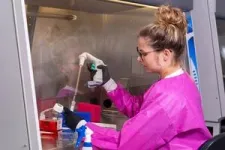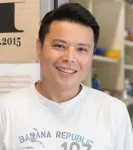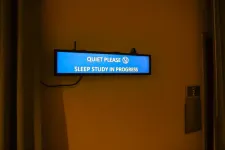(Press-News.org) HOUSTON – (Aug. 23, 2024) – The lotus leaf is a pioneer of self-cleaning, water-repellant engineering. Water droplets all but hover on its surface, whose unique texture traps air in its nanosized ridges and folds.
Rice University bioengineers report harnessing the lotus effect to develop a system for culturing cancer cell clusters that can shed light on hard-to-study tumor properties. The new zinc oxide-based culturing surface mimics the lotus leaf surface structure, providing a highly tunable platform for the high-throughput generation of three-dimensional nanoscale tumor models.
The superhydrophobic array device (SHArD) designed by Rice bioengineer Michael King and collaborators can be used to create tunable, compact, physiologically relevant models for studying the progression of cancer, including metastasis ⎯ the stage in the disease when cancerous cells travel through the bloodstream from a primary tumor site to other parts of the body.
“The study of metastasis ⎯ the leading cause of cancer deaths ⎯ poses a particular challenge in part due to the difficulty of developing accurate, high-throughput models,” said King, who is corresponding author on a study published in ACS Nano that describes the new culturing platform. “We hope this tool will unlock new knowledge about this problematic stage of the disease and help us identify ways to intervene in order to stop or prevent it from happening.”
Scientists and clinicians now rely on blood samples containing circulating tumor cells ⎯ a key marker of metastasis ⎯ to understand the properties of primary tumors as well as what causes cancer to spread. Often referred to as “liquid biopsy,” this sampling approach typically does not yield enough of a “catch” to enable in-depth, large-scale studies of metastatic processes.
“‘Safety in numbers’ unfortunately also applies to cancer cells circulating in the bloodstream,” said Alexandria Carter, a researcher in the King lab who is a co-author on the study. “Cancer cells traveling alone are more likely to succumb to shear stress destruction or immune cell attacks. However, when they travel in groups, the likelihood that they successfully reach and settle in other parts of the body increases.
“Those few lone cancer cells in a single blood draw are already rare, so isolating enough clusters for a detailed study is especially challenging. This is why SHArD is an exciting new tool for understanding primary and metastatic cancer.”
The King lab had previously succeeded in creating nanorod layers of halloysite, a naturally occurring substance whose texture promotes the adhesion of circulating tumor cells while simultaneously repelling blood cells.
“When Kalana Jayawardana joined our lab as a new postdoctoral fellow in 2018, he started to experiment with growing zinc oxide nanorod surfaces,” said King, a Cancer Prevention and Research Institute of Texas Scholar who recently joined Rice as the E.D. Butcher Chair of Bioengineering and special adviser to the provost on life science collaborations with the Texas Medical Center. “At first, we didn’t have a specific application in mind, but we were curious and hopeful that the new material would have special properties that would be useful for cancer biology.”
The project was later taken over by a doctoral student in the King lab, Maria Lopez-Cavestany, and took off in an exciting direction. Cavestany, now a Ph.D. graduate, is the first author on the study.
Once they were able to grow a stable “carpet” of zinc oxide nanotubes, the researchers added a teflonlike coating on top, in essence recreating the lotus leaf structure ⎯ nanoscale roughness combined with a hydrophobic layer that together gave rise to true superhydrophobicity, a word stemming from the Greek for “extreme fear of water.” To create SHArD, the researchers added a microwell grid with perfectly sized compartments, then tested the system to assess its performance.
“SHArD is ready to use in biomedical research,” Carter said. “Any lab with clean room access can follow our protocols and create versions of this platform that meet the exact needs of their specific research projects.”
Initially intended as a means to reliably culture primary tumor models at a higher throughput, SHArD is highly tunable and can easily be adapted to culture metastatic clusters as well. The fact that SHArD was successfully used to grow spheroidal models of primary tumors already expands the cancer modeling toolkit, making it possible to create superhydrophobic culturing devices in the absence of highly specialized equipment.
“The cluster-forming device has opened the door to new areas of research into the dangerous clusters found in the bloodstream of late-stage cancer patients,” King said.
The research was supported by the National Institutes of Health (CA203991). The content in this press release is solely the responsibility of the authors and does not necessarily represent the official views of the supporting entities.
-30-
This news release can be found online at news.rice.edu.
Follow Rice News and Media Relations via Twitter @RiceUNews.
Peer-reviewed paper:
Superhydrophobic Array Devices for the Enhanced Formation of 3D Cancer Models | ACS Nano | DOI: 10.1021/acsnano.4c08132
Authors: Maria Lopez-Cavestany, Olivia A. Wright, Noah T. Reckhorn, Alexandria T. Carter, Kalana Jayawardana, Tin Nguyen, Dayrl P. Briggs, Dmitry S. Koktysh, Alberto Esteban Linares, Deyu Li and Michael King
https://doi.org/10.1021/acsnano.4c08132
Image downloads:
https://drive.google.com/drive/folders/1vrDLsGEVw2pe7eJnPBN6Ypkw_jncOS7-?usp=drive_link (Photos by Gustavo Raskosky/Rice University)
About Rice:
Located on a 300-acre forested campus in Houston, Rice University is consistently ranked among the nation’s top 20 universities by U.S. News & World Report. Rice has highly respected schools of architecture, business, continuing studies, engineering, humanities, music, natural sciences and social sciences and is home to the Baker Institute for Public Policy. With 4,574 undergraduates and 3,982 graduate students, Rice’s undergraduate student-to-faculty ratio is just under 6-to-1. Its residential college system builds close-knit communities and lifelong friendships, just one reason why Rice is ranked No. 1 for lots of race/class interaction, No. 2 for best-run colleges and No. 12 for quality of life by the Princeton Review. Rice is also rated as a best value among private universities by Kiplinger’s Personal Finance.
END
Rice bioengineers develop lotus leaf-inspired system to advance study of cancer cell clusters
Device enables 3D nanoscale modeling of tumor progression
2024-08-23
ELSE PRESS RELEASES FROM THIS DATE:
To mask or not to mask: That is still the question
2024-08-23
CHICAGO --- Despite the association between mask mandates/mask wearing and reduced death rates during the pandemic, masking remains controversial and highly politicized, with many people still asking, “do masks work, and should they be recommended?”
In an editorial about the use of surgical face masks in public, published today, Aug. 23, in The BMJ, Northwestern Medicine internal medicine experts Drs. Jeffrey Linder and Rachel Amdur make the case for masking but acknowledge it’s not a cut-and-dried topic.
The ...
A switch for immune memory and anti-tumor immunity
2024-08-23
AUGUST 23, 2024, NEW YORK – A Ludwig Cancer Research study has identified a metabolic switch in the immune system’s T cells that is essential to the generation of memory T cells—which confer lasting immunity to previously encountered pathogens—and a T cell subtype found in tumors that drives anti-tumor responses during immunotherapy.
Led by Ludwig Lausanne’s Ping-Chih Ho and Alessio Bevilacqua and published in the current issue of Science Immunology, the study identifies PPARβ/δ, a master regulator of gene expression, as that essential molecular switch. Ho, Bevilacqua and their colleagues also show that the switch’s dysfunction compromises ...
Study finds nearly half of U.S. counties have at least one ‘pharmacy desert’
2024-08-23
COLUMBUS, Ohio – Nearly half of counties in the United States have at least one ‘pharmacy desert’ where there is no retail pharmacy within 10 miles, according to a new study published by researchers at The Ohio State University Comprehensive Cancer Center – Arthur G. James Cancer Hospital and Richard J. Solove Research Institute (OSUCCC – James).
“As pharmacies close, more and more Americans are left without easy access to medications, with disproportionate consequences on certain communities. We found that patients in counties with higher social vulnerabilities and fewer primary care providers were up to 40% more likely to reside in a region ...
MSU study finds placebos reduce stress, anxiety, depression — even when people know they are placebos
2024-08-23
MSU has a satellite uplink/LTN TV studio and Comrex line for radio interviews upon request.
EAST LANSING, Mich. – A study out of Michigan State University found that nondeceptive placebos, or placebos given with people fully knowing they are placebos, effectively manage stress — even when the placebos are administered remotely.
Researchers recruited participants experiencing prolonged stress from the COVID-19 pandemic for a two-week randomized controlled trial. Half of the ...
MSU discovers method for CRISPR-based genome editing in Nile grass rats
2024-08-23
EAST LANSING, Mich. – A team of researchers at Michigan State University has discovered a set of methods that enabled the first successful CRISPR-based genome editing in Nile grass rats.
The study, published in BMC Biology, is the first to successfully edit genomes in Nile grass rats. As diurnal rodents, Nile grass rats have similar sleep/awake patterns to humans which could be advantageous in preclinical or translational research.
Currently, preclinical research relies heavily on laboratory mice, which are nocturnal rodents who are active at night and sleep during the day. With these different sleep patterns, diurnal and nocturnal ...
UVA engineering professors target inclusive AI education with $1 million grant
2024-08-23
Underserved high school students often lack access to artificial intelligence education that could prepare them for future careers in technology. Researchers at the University of Virginia School of Engineering and Applied Science and Clemson University are hoping to change that.
To help bridge the educational divide, the research team received a $1 million grant from the National Science Foundation to democratize access to AI education. Future fair and equitable technologies depend on a robust AI education, and expanding access to that education is crucial.
The project is part of the NSF’s Experiential Learning for ...
Kids now see fewer TV ads for unhealthy food and drinks, but exposure remains high
2024-08-23
Children’s exposure to food and drink ads during kids’ TV shows has dropped substantially since food and beverage makers pledged to stop advertising unhealthy fare during children’s TV shows. Yet, according to research from the University of Illinois Chicago, children under 12 still see more than 1,000 food-related ads a year, most of them for unhealthy products.
For the study, published in JAMA Network Open, researchers analyzed television ratings and advertising data from 2013 through 2022. The study authors found that a dramatic decline in food and drink advertisements during kids’ shows did not ...
Good sleep habits important for overweight adults, OHSU study suggests
2024-08-23
New research from Oregon Health & Science University reveals negative health consequences for people who are overweight and ignore their body’s signals to sleep at night, with specific differences between men and women.
The study published this week in The Journal of Clinical Endocrinology & Metabolism.
“This study builds support for the importance of good sleep habits,” said lead author Brooke Shafer, Ph.D., a postdoctoral researcher in the Sleep, Chronobiology and Health Laboratory in the OHSU School of Nursing. “Sleep practices, like going to bed when you’re tired or setting aside your screen at ...
Pendulum Therapeutics and BiomeSense launch pioneering study on gut microbiome using continuous sampling technology
2024-08-23
San Francisco, CA (August 12, 2024) – Pendulum Therapeutics, in collaboration with BiomeSense, announces the launch of an innovative new pilot study entitled "Detection of Akkermansia muciniphila Utilizing Serial Longitudinal Samples with the BiomeSense GutLab™: An Open-Label Proof of Concept Study." Pendulum Therapeutics and BiomeSense are two biotech companies at the forefront of microbiome science. Their groundbreaking research aims to advance the scientific understanding of the human microbiome by focusing on continuous detection of Akkermansia muciniphila, a keystone strain in the gut microbiome, using a new data generation technology.
About ...
Unconventional interface superconductor could benefit quantum computing
2024-08-23
RIVERSIDE, Calif. -- A multi-institutional team of scientists in the United States, led by physicist Peng Wei at the University of California, Riverside, has developed a new superconductor material that could potentially be used in quantum computing and be a candidate “topological superconductor.”
Topology is the mathematics of shape. A topological superconductor uses a delocalized state of an electron or hole (a hole behaves like an electron with positive charge) to carry quantum information and process data in a robust manner.
The researchers report today in Science Advances that they combined trigonal tellurium ...
LAST 30 PRESS RELEASES:
Community water fluoridation not linked to lower birth weight, large US study finds
Stanford University’s Guosong Hong announced as inaugural recipient of the SPIE Biophotonics Discovery’s Impact of the Year Award
Ice, ice, maybe: There’s always a thin layer of water on ice — or is there?
Machine learning lends a helping ‘hand’ to prosthetics
Noninvasive brain scanning could send signals to paralyzed limbs
Community water fluoridation and birth outcomes
SGLT2 inhibitors vs GLP-1 receptor agonists for kidney outcomes in individuals with type 2 diabetes
Long-term exposure to air pollution and risk and prognosis of motor neuron disease
Five-year absolute risk–based and age-based breast cancer screening in the US
Study finds elevated alcohol involvement in suicides of lesbian, gay and bisexual women
Air pollution may increase the risk of the neurodegenerative disease ALS
Chronic kidney disease poisons patients’ hearts, scientists discover
Hollings researchers reveal why some pancreatic tumors behave differently
DNA ties gut motility to vitamin B1
Study suggests pathway for life-sustaining conditions in Europa’s ocean
Researchers discover potential new target to treat Parkinson’s disease
Global societies unite to address environmental threats to heart health
Artificial light at night extends pollen season
Women see AI as riskier than men do
Push and pull in models of human migration
Mapping comedic timing, ta-da!
SEOULTECH researchers reveal strong public support for hydrogen fuel cell trucks
Dongguk University develops a new way to produce cheaper, more efficient green hydrogen
Scientists discover a hidden RNA “aging clock” in human sperm
New quantum boundary discovered: Spin size determines how the Kondo effect behaves
Ancient ‘spaghetti’ in dogs’ hearts reveals surprising origins of heartworm
Full value added tax on meat: a first step towards pricing the environmental damages caused by diets
Hidden mpox exposure detected in healthy Nigerian adults, revealing under-recognized transmission
Shingles vaccine linked to slower biological aging in older adults
A self-assembling shortcut to better organic solar cells
[Press-News.org] Rice bioengineers develop lotus leaf-inspired system to advance study of cancer cell clustersDevice enables 3D nanoscale modeling of tumor progression
